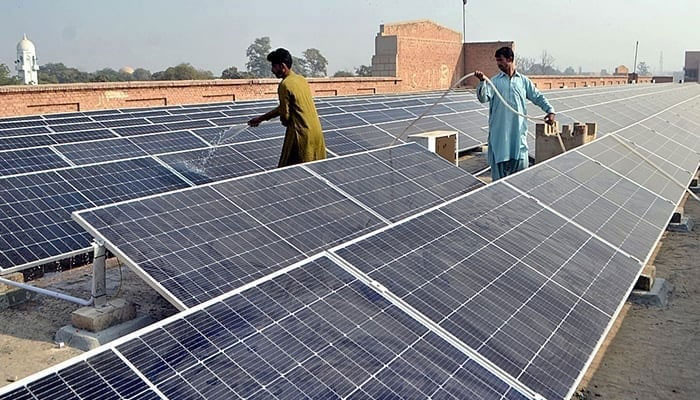Solar initiative
Estimated at Rs55 billion, with the federal government covering 70 per cent of the project’s expenses
Prime Minister Shehbaz Sharif has announced a much-needed scheme for farmers in Balochistan on behalf of the federal and Balochistan governments. Estimated at Rs55 billion, with the federal government covering 70 per cent of the project’s expenses, 28,000 tube wells in Balochistan will be solarized to provide farmers with cheap electricity. PM Shehbaz has said he is confident that Balochistan Chief Minister Sarfraz Bugti will be able to implement the project within three months. He highlighted that these tube wells were connected to the power grid but were barely active for two hours because people don’t pay their bills. Now farmers will be able to use their tube wells at minimal electricity cost since solar is the world’s cheapest power source; this will also save billions of rupees in subsidy to the Quetta Electric Supply Company. This is a step in the right direction for many reasons.
At a time when the entire country is reeling from the budget and the increase in electricity tariffs, this initiative will ensure that 28,000 farmers can survive its effects. Without tube wells, crops were also being affected. Like other sectors, Pakistan’s agriculture sector has also borne the brunt of loadshedding and high electricity prices. That the federal and provincial governments are encouraging farmers to go solar shows that the government wants to provide targeted relief to those affected by the worst. Solar is not just clean renewable energy but something that is needed for a country like Pakistan, which is a victim of climate change. Another reason solar power should be used is that the abundant sunlight will not go to waste while providing great financial relief to these farmers. Such projects should not just be limited to Balochistan, but encouraged elsewhere as well for farmers and regular citizens. Just recently, CM Maryam Nawaz approved providing solar panels to people consuming 50 to 500 units of electricity monthly. Per this policy, 90 per cent of the solar panels’ cost will be paid by the provincial government and 10 per cent by consumers. Reportedly, the Sindh government aims to provide solar systems to 200,000 households across the province. There is consensus across the board that solarization is the way forward. Pakistan has been one of those countries that incentivized solar power and the government is now making use of this renewable energy source to give relief to the masses.
In another move, PM Shehbaz on Tuesday announced that the government will not be increasing the electricity rates for protected customers who consume up to 200 units of power for three months and that they will get a subsidy for July, August and September. These are good steps that will give relief to consumers who are struggling to survive the rising cost of living. Targeted relief for the people will make the lives of the lower-income groups much more bearable. The government should come up with more such initiatives so that those who cannot afford to pay high electricity bills do not live without the bare minimum.
-
 Prince Harry Considering ‘half-in, Half-out’ Royal Role Amid UK Trip?
Prince Harry Considering ‘half-in, Half-out’ Royal Role Amid UK Trip? -
 CBS Finally Airs Trump’s Full Interview 'pulled' Earlier After White House Threatens To Sue
CBS Finally Airs Trump’s Full Interview 'pulled' Earlier After White House Threatens To Sue -
 Robert Irwin Gets Honest About Being In South Africa After 'DWTS' Run In LA
Robert Irwin Gets Honest About Being In South Africa After 'DWTS' Run In LA -
 Queen Elizabeth’s Icy Response To Andrew, Jeffrey Epstein Scandal Revealed
Queen Elizabeth’s Icy Response To Andrew, Jeffrey Epstein Scandal Revealed -
 Trump Vows To Neutralize ‘Russian Threat’ From Greenland, Raising Arctic Stakes
Trump Vows To Neutralize ‘Russian Threat’ From Greenland, Raising Arctic Stakes -
 Green Day Revealed As Super Bowl 2026 Opening Act
Green Day Revealed As Super Bowl 2026 Opening Act -
 Trump's Greenland Tariff ‘blackmail’ Sparks EU Retaliation: Is ‘trade Bazooka’ Next?
Trump's Greenland Tariff ‘blackmail’ Sparks EU Retaliation: Is ‘trade Bazooka’ Next? -
 New Drug Shows Promise In Lowering Dangerous Blood Fats
New Drug Shows Promise In Lowering Dangerous Blood Fats -
 Real Reason Noah Schnapp Was Missing From Finn Wolfhard's 'SNL' Debut Revealed
Real Reason Noah Schnapp Was Missing From Finn Wolfhard's 'SNL' Debut Revealed -
 How Princes William, Harry Were Caught In Early Royal Controversy Involving Charles
How Princes William, Harry Were Caught In Early Royal Controversy Involving Charles -
 Prince Harry’s Absence Leaves Gap For Royal Family Among Young People
Prince Harry’s Absence Leaves Gap For Royal Family Among Young People -
 Karley Scott Collins Breaks Silence On Keith Urban Dating Rumours
Karley Scott Collins Breaks Silence On Keith Urban Dating Rumours -
 Timothee Chalamet Is Still A 'normal Guy,' Says Kevin O'Leary
Timothee Chalamet Is Still A 'normal Guy,' Says Kevin O'Leary -
 Henry Winkler Opens Up On His Special Bond With Adam Sandler: 'Filled With Warmth'
Henry Winkler Opens Up On His Special Bond With Adam Sandler: 'Filled With Warmth' -
 Bruce Springsteen Makes Strong Political Statement
Bruce Springsteen Makes Strong Political Statement -
 Prince Harry Relationship With King Charles 'not Straightforward,' Says Expert
Prince Harry Relationship With King Charles 'not Straightforward,' Says Expert




